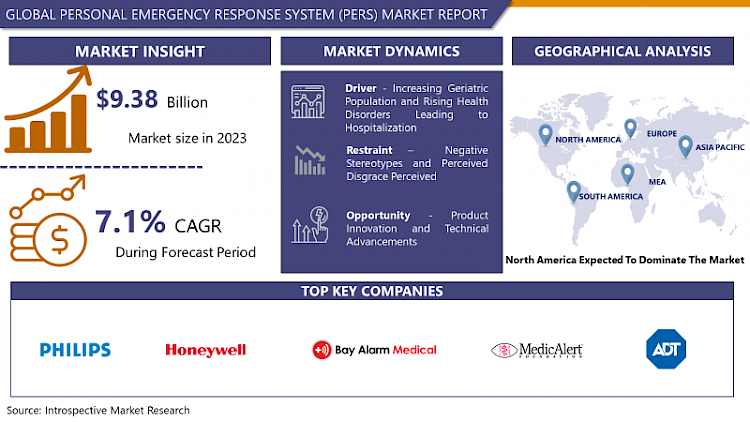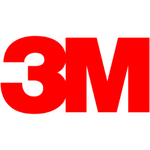Personal Emergency Response System (PERS) Market Synopsis
The global market for PERS) estimated at USD 9.38 Billion in the year 2023, is expected to reach a revised size of USD 17.39 Billion by 2032, growing at a CAGR of 7.1% over the forecast period 2024-2032.
Personal Emergency Response Systems (PERS) which are also commonly known as Medical Emergency Response Systems are devices that enable people to call for help in an emergency by simply pushing a button. These devices are certainly designed for recipients who are at high risk of institutionalization and need help in an emergency. PERS services are for people of age 14 and older, who live alone or are alone for significant parts of the day and who would require extensive routine supervision.
- Personal Emergency Response Systems (PERS) is a convenient, simple, and efficient way to call for help in an emergency. One can seek help just by activating the device with the push of a button, PERS provides a level of comfort for seniors and also for family living at a distance. The PERS simply works by alerting all appropriate emergency channels after its activation. The response is quick and hence there's no delay in help. As a result, these simple and convenient devices proved to be very useful and occasionally a true life-saver.
- A PERS has three components: a small radio transmitter, a console connected to a telephone, and an emergency response center that monitors calls. Transmitters are lightweight battery-powered devices that are to be worn around the neck or on the wrist or can also be put into a pocket. In an emergency the transmitter’s help button is pressed which sends a signal to the console, the console then automatically dials one or more emergency telephone numbers to call for help. Typically, a PERS is programmed to telephone an emergency response center. Finally, the center identifies the nature of your emergency which involves reviewing your medical history and checking who should be notified and then notifies the selected people.

The Personal Emergency Response System (PERS) Market Trend Analysis
Increasing Geriatric Population and Rising Health Disorders Leading to Hospitalisation
- Personal Emergency Response Systems are specifically developed for older adults who are left alone for a particular time of the day as they have a higher risk of falling as they age, and hence, the rise in the number of old people is certainly the reason behind the greater demand for such alert systems.
- Recent Studies have concluded that around 30% of people who are over the age of 65 fall every year, and more than 50% of people over the age of 80 fall every year. People at this age usually have some kind of disease such as Parkinson’s, Alzheimer’s, epilepsy, multiple sclerosis, muscular dystrophy, Amyotrophic Lateral Sclerosis, muscle-weakening neurological diseases, and diabetes. Such disorder creates an even greater risk if they stay alone.
- Also, when it comes to hospitalisation, older adults have a similar average length of stay when compared with adults 45 to 64 years, but older adults require more support after discharge, due to functional disability. having an in-home caregiver can help to an extent but this does not help in every situation. And such emerging risks are hence driving the need for Personal Emergency Response System (PERS) that can be with people all the time and can help them by alerting others when needed.
Product Innovation and Technical Advancements to Suit All Ages, Abilities, and Preferences and Rising Adoption of Smartphones among Older People
- Presently, around 90 percent of adults of age 50 and older would prefer to stay in their homes, instead of in nursing homes, and in such cases, Personal Emergency Response Systems (PERS) as medical alert systems helps a lot in maintaining independence safety for seniors. Further, New advances in mobile capabilities and sensors are now continuously building into these systems which enables better connectivity opportunities offered by advanced technologies like the Internet of Things (IoT).
- Today’s PERS technology is evolved to a very great extent as compared to what it used to be in the past few years. Today, PERS has a landline, cellular, mobile, GPS tracking, fall detection, WiFi tracking, and many more features to it. All these innovations help customers to get protection and safety that’s best suited for them. These new advancements such as cellular technology, WiFi, and GPS in medical alert systems are now more portable than before.
- Personal Emergency Response Systems (PERS) are getting popularly known as live savers not only in the healthcare world but also for day to day lives, they can be people at all times and can help by alerting others when one falls, when there is a fire or a burglar in the house and such huge demand along with the constantly on-going advancements will allow customers to have peace of mind while in their homes or going out to any other place, which is ultimately expected to boost the demand of the PERS even further.
Segmentation Analysis Of The Personal Emergency Response System (PERS) Market
Personal Emergency Response System (PERS) market segments cover the Type and End-User. By Type, Mobile PERS and Standalone PERS segments are Expected to Dominate the Market during the upcoming period.
- The mobility factor added by the mobile PERS or mPERS is the primary driver of its growth in the global Personal Emergency Response System Market. the option provided by such PERS to leave patients or the wanted to leave at the home without losing the protective shield PERS device offers is invaluable. In addition to mobility options, mPERS devices also come with GPS and WiFi locating technologies, and hence these devices are able to identify the exact location of a subscriber once the button is pushed.
- Immediate emergency assistance and More independence everywhere and every time are provided by such remote PERS standalone or mobile-based. Whether the user is at a park, in a store, or in their backyard, the application of both locating technologies extends the device’s utility beyond the walls of the home. And such systems are even of greater help when it comes to emergencies and accidents, which are most devastating and also common at the same time. For instance, according to Statista, unintentional injuries or accidents accounted for more than 200,000 deaths in the US alone in 2020. This added up to a global record of 3.16 million based on the WHO's data.
- Such Increased peace of mind at home and outside of the home provided by remote PERS technologies through mPERS is expected to boost the growth of this segment in the upcoming years.
Regional Analysis of The Personal Emergency Response System (PERS) Market
North America Dominates the Global Market of Personal Emergency Response System (PERS) And It Is Also Expected to Dominate the Market Over the Forecast Period.
- North American Countries such as the United States are the ones having rapidly rising chronic diseases and also the greater older population, there are approximately 13.2 million hospitalizations for adults aged 65 years and older in the United States each year, which includes medical conditions (67%), surgeries (25%), injuries (6%), and mental health and substance use conditions (2%). Such a rising number of hospitalisations and adults having movement restrictions or functional disabilities are driving the demand for Personal Emergency Response Systems in North America.
- This number of health disorders has even seen increases in the last 3-5 years. In 2019, almost 7% of people aged 18 to 44 years in the United States were hospitalized at least once. Furthermore, hospitalization among people aged 65 years and older was higher at almost 17%.
- Moreover, improved healthcare facilities and early adoption of any new technology is also greater in North American Developed Countries as compared to other parts of the world which all together is leading the regional markets of North America towards growth.
- Asia-Pacific is also expected to show a healthy growth rate in the market due to the increasing geriatric population and also due to implementation of home-based health programs.
Covid-19 Impact Analysis On Personal Emergency Response System (PERS) Market
- The COVID-19 pandemic has had a favorable impact on the application of Personal Emergency Response Systems owing to the growing demand for personal health monitoring systems across nursing homes and also by home-based users. Patients of all ages suffering from chronic diseases during COVID-19 were advised to avoid physical visits to hospitals to not to get infected.
- Even the hospitals were full due to the greater number of patients during that time which included a large number of adult people too. For instance, Overall, 31% of cases, 45% of hospitalizations, 53% of ICU admissions, and 80% of deaths associated with COVID-19 were among adults aged greater than 65 years with the highest percentage of severe outcomes among persons that were aged more than 85 years. This hospitalisation rate especially among adults led to the development of the market for PERS during the pandemic.
- Furthermore, PERS offering integration between remote patient monitoring platforms and healthcare facilities was of great importance. This helped to remote access through health platforms to essential healthcare services, which resulted in the continued use of PERS amid the COVID-19 pandemic also. Hence, benefits provided by Personal Emergency Response Systems such as patient safety, and accessible options for preventive, routine care of the patients during the pandemic were deciding factors for the market growth during that time.
Top Key Players Covered in The Personal Emergency Response System (PERS) Market
- Koninklijke Philips N.V. (Netherlands)
- Honeywell International Inc (US)
- Life Alert Emergency Response Inc. (US)
- AlertONE Service Inc. (US)
- MedicAlert Foundation (US)
- ADT Security Services Inc. (US)
- Bay Alarm Medical (US)
- Shenzhen Giftshine Technology Co. Ltd. (China)
- Nortek Security & Control LLC (US)
- Galaxy Medical Alert Systems Ltd. (Canada)
- Medical Guardian LLP (US)
- Rope Innovation Co. Ltd. (China)
- Electronic Caregiver Inc. (US)
- Ningbo Hi-Tech Park Jabo Electronics Co. Ltd (China)
- Vanguard Wireless (Australia)
- Tynetec Ltd. (UK) and Other Major Players
Key Industry Developments in the Personal Emergency Response System (PERS) Market
- In February 2024, KORE, a global leader in IoT solutions, and Medical Guardian, a leading provider of personal emergency response systems, announced their groundbreaking collaboration on the first eSIM-powered medical alert device. This revolutionary device addresses cell signal challenges and healthcare access disparities by enabling electronic switching of service carriers for optimal 24/7 connectivity. This innovation marks a significant advancement in ensuring reliable and continuous emergency response services for users, enhancing their safety and healthcare accessibility.
- In October 2023, Bay Alarm Medical, a leading PERS provider, introduced the BayConnect, a medical alert smartwatch featuring fall detection, emergency response button, medication reminders, and health tracking. This smartwatch caters to a tech-savvy demographic who prefer a discreet and stylish alternative to traditional PERS devices.
- In September 2023, Lively, known for its mobile PERS solutions, launched the Lively Finish, a lightweight and waterproof wristband with fall detection and emergency response. This device targets active seniors who participate in outdoor activities like hiking or swimming.
|
Global Personal Emergency Response System (PERS) Market |
|||
|
Base Year: |
2023 |
Forecast Period: |
2024-2032 |
|
Historical Data: |
2017 to 2023 |
Market Size in 2023: |
USD 9.38 Bn. |
|
Forecast Period 2024-32 CAGR: |
7.1% |
Market Size in 2032: |
USD 17.39 Bn. |
|
Segments Covered: |
By Type |
|
|
|
By End-User |
|
||
|
By Region |
|
||
|
Key Market Drivers: |
|
||
|
Key Market Restraints: |
|
||
|
Key Opportunities: |
|
||
|
Companies Covered in the report: |
|
||
Chapter 1: Introduction
1.1 Research Objectives
1.2 Research Methodology
1.3 Research Process
1.4 Scope and Coverage
1.4.1 Market Definition
1.4.2 Key Questions Answered
1.5 Market Segmentation
Chapter 2:Executive Summary
Chapter 3:Growth Opportunities By Segment
3.1 By Type
3.2 By End-User
Chapter 4: Market Landscape
4.1 Porter's Five Forces Analysis
4.1.1 Bargaining Power of Supplier
4.1.2 Threat of New Entrants
4.1.3 Threat of Substitutes
4.1.4 Competitive Rivalry
4.1.5 Bargaining Power Among Buyers
4.2 Industry Value Chain Analysis
4.3 Market Dynamics
4.3.1 Drivers
4.3.2 Restraints
4.3.3 Opportunities
4.5.4 Challenges
4.4 Pestle Analysis
4.5 Technological Roadmap
4.6 Regulatory Landscape
4.7 SWOT Analysis
4.8 Price Trend Analysis
4.9 Patent Analysis
4.10 Analysis of the Impact of Covid-19
4.10.1 Impact on the Overall Market
4.10.2 Impact on the Supply Chain
4.10.3 Impact on the Key Manufacturers
4.10.4 Impact on the Pricing
Chapter 5: Personal Emergency Response System (PERS) Market by Type
5.1 Personal Emergency Response System (PERS) Market Overview Snapshot and Growth Engine
5.2 Personal Emergency Response System (PERS) Market Overview
5.3 Standalone PERS
5.3.1 Introduction and Market Overview
5.3.2 Historic and Forecasted Market Size (2017-2032F)
5.3.3 Key Market Trends, Growth Factors and Opportunities
5.3.4 Standalone PERS: Geographic Segmentation
5.4 Landline PERS
5.4.1 Introduction and Market Overview
5.4.2 Historic and Forecasted Market Size (2017-2032F)
5.4.3 Key Market Trends, Growth Factors and Opportunities
5.4.4 Landline PERS: Geographic Segmentation
5.5 Mobile PERS
5.5.1 Introduction and Market Overview
5.5.2 Historic and Forecasted Market Size (2017-2032F)
5.5.3 Key Market Trends, Growth Factors and Opportunities
5.5.4 Mobile PERS: Geographic Segmentation
Chapter 6: Personal Emergency Response System (PERS) Market by End-User
6.1 Personal Emergency Response System (PERS) Market Overview Snapshot and Growth Engine
6.2 Personal Emergency Response System (PERS) Market Overview
6.3 Home-Based Users
6.3.1 Introduction and Market Overview
6.3.2 Historic and Forecasted Market Size (2017-2032F)
6.3.3 Key Market Trends, Growth Factors and Opportunities
6.3.4 Home-Based Users: Geographic Segmentation
6.4 Assisted Living Facilities
6.4.1 Introduction and Market Overview
6.4.2 Historic and Forecasted Market Size (2017-2032F)
6.4.3 Key Market Trends, Growth Factors and Opportunities
6.4.4 Assisted Living Facilities: Geographic Segmentation
6.5 Nursing Homes
6.5.1 Introduction and Market Overview
6.5.2 Historic and Forecasted Market Size (2017-2032F)
6.5.3 Key Market Trends, Growth Factors and Opportunities
6.5.4 Nursing Homes: Geographic Segmentation
6.6 Senior Living Facilities
6.6.1 Introduction and Market Overview
6.6.2 Historic and Forecasted Market Size (2017-2032F)
6.6.3 Key Market Trends, Growth Factors and Opportunities
6.6.4 Senior Living Facilities: Geographic Segmentation
6.7 Hospice Care
6.7.1 Introduction and Market Overview
6.7.2 Historic and Forecasted Market Size (2017-2032F)
6.7.3 Key Market Trends, Growth Factors and Opportunities
6.7.4 Hospice Care: Geographic Segmentation
Chapter 7: Company Profiles and Competitive Analysis
7.1 Competitive Landscape
7.1.1 Competitive Positioning
7.1.2 Personal Emergency Response System (PERS) Sales and Market Share By Players
7.1.3 Industry BCG Matrix
7.1.4 Heat Map Analysis
7.1.5 Personal Emergency Response System (PERS) Industry Concentration Ratio (CR5 and HHI)
7.1.6 Top 5 Personal Emergency Response System (PERS) Players Market Share
7.1.7 Mergers and Acquisitions
7.1.8 Business Strategies By Top Players
7.2 KONINKLIJKE PHILIPS N.V. (NETHERLANDS)
7.2.1 Company Overview
7.2.2 Key Executives
7.2.3 Company Snapshot
7.2.4 Operating Business Segments
7.2.5 Product Portfolio
7.2.6 Business Performance
7.2.7 Key Strategic Moves and Recent Developments
7.2.8 SWOT Analysis
7.3 HONEYWELL INTERNATIONAL INC (US)
7.4 LIFE ALERT EMERGENCY RESPONSE INC. (US)
7.5 ALERTONE SERVICE INC. (US)
7.6 MEDICALERT FOUNDATION (US)
7.7 ADT SECURITY SERVICES INC. (US)
7.8 BAY ALARM MEDICAL (US)
7.9 SHENZHEN GIFTSHINE TECHNOLOGY CO. LTD. (CHINA)
7.10 NORTEK SECURITY & CONTROL LLC (US)
7.11 GALAXY MEDICAL ALERT SYSTEMS LTD. (CANADA)
7.12 MEDICAL GUARDIAN LLP (US)
7.13 ROPE INNOVATION CO. LTD. (CHINA)
7.14 ELECTRONIC CAREGIVER INC. (US)
7.15 NINGBO HI-TECH PARK JABO ELECTRONICS CO. LTD (CHINA)
7.16 VANGUARD WIRELESS (AUSTRALIA)
7.17 TYNETEC LTD. (UK)
7.18 OTHER MAJOR PLAYERS
Chapter 8: Global Personal Emergency Response System (PERS) Market Analysis, Insights and Forecast, 2017-2032
8.1 Market Overview
8.2 Historic and Forecasted Market Size By Type
8.2.1 Standalone PERS
8.2.2 Landline PERS
8.2.3 Mobile PERS
8.3 Historic and Forecasted Market Size By End-User
8.3.1 Home-Based Users
8.3.2 Assisted Living Facilities
8.3.3 Nursing Homes
8.3.4 Senior Living Facilities
8.3.5 Hospice Care
Chapter 9: North America Personal Emergency Response System (PERS) Market Analysis, Insights and Forecast, 2017-2032
9.1 Key Market Trends, Growth Factors and Opportunities
9.2 Impact of Covid-19
9.3 Key Players
9.4 Key Market Trends, Growth Factors and Opportunities
9.4 Historic and Forecasted Market Size By Type
9.4.1 Standalone PERS
9.4.2 Landline PERS
9.4.3 Mobile PERS
9.5 Historic and Forecasted Market Size By End-User
9.5.1 Home-Based Users
9.5.2 Assisted Living Facilities
9.5.3 Nursing Homes
9.5.4 Senior Living Facilities
9.5.5 Hospice Care
9.6 Historic and Forecast Market Size by Country
9.6.1 U.S.
9.6.2 Canada
9.6.3 Mexico
Chapter 10: Europe Personal Emergency Response System (PERS) Market Analysis, Insights and Forecast, 2017-2032
10.1 Key Market Trends, Growth Factors and Opportunities
10.2 Impact of Covid-19
10.3 Key Players
10.4 Key Market Trends, Growth Factors and Opportunities
10.4 Historic and Forecasted Market Size By Type
10.4.1 Standalone PERS
10.4.2 Landline PERS
10.4.3 Mobile PERS
10.5 Historic and Forecasted Market Size By End-User
10.5.1 Home-Based Users
10.5.2 Assisted Living Facilities
10.5.3 Nursing Homes
10.5.4 Senior Living Facilities
10.5.5 Hospice Care
10.6 Historic and Forecast Market Size by Country
10.6.1 Germany
10.6.2 U.K.
10.6.3 France
10.6.4 Italy
10.6.5 Russia
10.6.6 Spain
10.6.7 Rest of Europe
Chapter 11: Asia-Pacific Personal Emergency Response System (PERS) Market Analysis, Insights and Forecast, 2017-2032
11.1 Key Market Trends, Growth Factors and Opportunities
11.2 Impact of Covid-19
11.3 Key Players
11.4 Key Market Trends, Growth Factors and Opportunities
11.4 Historic and Forecasted Market Size By Type
11.4.1 Standalone PERS
11.4.2 Landline PERS
11.4.3 Mobile PERS
11.5 Historic and Forecasted Market Size By End-User
11.5.1 Home-Based Users
11.5.2 Assisted Living Facilities
11.5.3 Nursing Homes
11.5.4 Senior Living Facilities
11.5.5 Hospice Care
11.6 Historic and Forecast Market Size by Country
11.6.1 China
11.6.2 India
11.6.3 Japan
11.6.4 Singapore
11.6.5 Australia
11.6.6 New Zealand
11.6.7 Rest of APAC
Chapter 12: Middle East & Africa Personal Emergency Response System (PERS) Market Analysis, Insights and Forecast, 2017-2032
12.1 Key Market Trends, Growth Factors and Opportunities
12.2 Impact of Covid-19
12.3 Key Players
12.4 Key Market Trends, Growth Factors and Opportunities
12.4 Historic and Forecasted Market Size By Type
12.4.1 Standalone PERS
12.4.2 Landline PERS
12.4.3 Mobile PERS
12.5 Historic and Forecasted Market Size By End-User
12.5.1 Home-Based Users
12.5.2 Assisted Living Facilities
12.5.3 Nursing Homes
12.5.4 Senior Living Facilities
12.5.5 Hospice Care
12.6 Historic and Forecast Market Size by Country
12.6.1 Turkey
12.6.2 Saudi Arabia
12.6.3 Iran
12.6.4 UAE
12.6.5 Africa
12.6.6 Rest of MEA
Chapter 13: South America Personal Emergency Response System (PERS) Market Analysis, Insights and Forecast, 2017-2032
13.1 Key Market Trends, Growth Factors and Opportunities
13.2 Impact of Covid-19
13.3 Key Players
13.4 Key Market Trends, Growth Factors and Opportunities
13.4 Historic and Forecasted Market Size By Type
13.4.1 Standalone PERS
13.4.2 Landline PERS
13.4.3 Mobile PERS
13.5 Historic and Forecasted Market Size By End-User
13.5.1 Home-Based Users
13.5.2 Assisted Living Facilities
13.5.3 Nursing Homes
13.5.4 Senior Living Facilities
13.5.5 Hospice Care
13.6 Historic and Forecast Market Size by Country
13.6.1 Brazil
13.6.2 Argentina
13.6.3 Rest of SA
Chapter 14 Investment Analysis
Chapter 15 Analyst Viewpoint and Conclusion
|
Global Personal Emergency Response System (PERS) Market |
|||
|
Base Year: |
2023 |
Forecast Period: |
2024-2032 |
|
Historical Data: |
2017 to 2023 |
Market Size in 2023: |
USD 9.38 Bn. |
|
Forecast Period 2024-32 CAGR: |
7.1% |
Market Size in 2032: |
USD 17.39 Bn. |
|
Segments Covered: |
By Type |
|
|
|
By End-User |
|
||
|
By Region |
|
||
|
Key Market Drivers: |
|
||
|
Key Market Restraints: |
|
||
|
Key Opportunities: |
|
||
|
Companies Covered in the report: |
|
||
LIST OF TABLES
TABLE 001. EXECUTIVE SUMMARY
TABLE 002. PERSONAL EMERGENCY RESPONSE SYSTEM (PERS) MARKET BARGAINING POWER OF SUPPLIERS
TABLE 003. PERSONAL EMERGENCY RESPONSE SYSTEM (PERS) MARKET BARGAINING POWER OF CUSTOMERS
TABLE 004. PERSONAL EMERGENCY RESPONSE SYSTEM (PERS) MARKET COMPETITIVE RIVALRY
TABLE 005. PERSONAL EMERGENCY RESPONSE SYSTEM (PERS) MARKET THREAT OF NEW ENTRANTS
TABLE 006. PERSONAL EMERGENCY RESPONSE SYSTEM (PERS) MARKET THREAT OF SUBSTITUTES
TABLE 007. PERSONAL EMERGENCY RESPONSE SYSTEM (PERS) MARKET BY TYPE
TABLE 008. STANDALONE PERS MARKET OVERVIEW (2016-2028)
TABLE 009. LANDLINE PERS MARKET OVERVIEW (2016-2028)
TABLE 010. MOBILE PERS MARKET OVERVIEW (2016-2028)
TABLE 011. PERSONAL EMERGENCY RESPONSE SYSTEM (PERS) MARKET BY END-USER
TABLE 012. HOME-BASED USERS MARKET OVERVIEW (2016-2028)
TABLE 013. ASSISTED LIVING FACILITIES MARKET OVERVIEW (2016-2028)
TABLE 014. NURSING HOMES MARKET OVERVIEW (2016-2028)
TABLE 015. SENIOR LIVING FACILITIES MARKET OVERVIEW (2016-2028)
TABLE 016. HOSPICE CARE MARKET OVERVIEW (2016-2028)
TABLE 017. NORTH AMERICA PERSONAL EMERGENCY RESPONSE SYSTEM (PERS) MARKET, BY TYPE (2016-2028)
TABLE 018. NORTH AMERICA PERSONAL EMERGENCY RESPONSE SYSTEM (PERS) MARKET, BY END-USER (2016-2028)
TABLE 019. N PERSONAL EMERGENCY RESPONSE SYSTEM (PERS) MARKET, BY COUNTRY (2016-2028)
TABLE 020. EUROPE PERSONAL EMERGENCY RESPONSE SYSTEM (PERS) MARKET, BY TYPE (2016-2028)
TABLE 021. EUROPE PERSONAL EMERGENCY RESPONSE SYSTEM (PERS) MARKET, BY END-USER (2016-2028)
TABLE 022. PERSONAL EMERGENCY RESPONSE SYSTEM (PERS) MARKET, BY COUNTRY (2016-2028)
TABLE 023. ASIA PACIFIC PERSONAL EMERGENCY RESPONSE SYSTEM (PERS) MARKET, BY TYPE (2016-2028)
TABLE 024. ASIA PACIFIC PERSONAL EMERGENCY RESPONSE SYSTEM (PERS) MARKET, BY END-USER (2016-2028)
TABLE 025. PERSONAL EMERGENCY RESPONSE SYSTEM (PERS) MARKET, BY COUNTRY (2016-2028)
TABLE 026. MIDDLE EAST & AFRICA PERSONAL EMERGENCY RESPONSE SYSTEM (PERS) MARKET, BY TYPE (2016-2028)
TABLE 027. MIDDLE EAST & AFRICA PERSONAL EMERGENCY RESPONSE SYSTEM (PERS) MARKET, BY END-USER (2016-2028)
TABLE 028. PERSONAL EMERGENCY RESPONSE SYSTEM (PERS) MARKET, BY COUNTRY (2016-2028)
TABLE 029. SOUTH AMERICA PERSONAL EMERGENCY RESPONSE SYSTEM (PERS) MARKET, BY TYPE (2016-2028)
TABLE 030. SOUTH AMERICA PERSONAL EMERGENCY RESPONSE SYSTEM (PERS) MARKET, BY END-USER (2016-2028)
TABLE 031. PERSONAL EMERGENCY RESPONSE SYSTEM (PERS) MARKET, BY COUNTRY (2016-2028)
TABLE 032. KONINKLIJKE PHILIPS N.V. (NETHERLANDS): SNAPSHOT
TABLE 033. KONINKLIJKE PHILIPS N.V. (NETHERLANDS): BUSINESS PERFORMANCE
TABLE 034. KONINKLIJKE PHILIPS N.V. (NETHERLANDS): PRODUCT PORTFOLIO
TABLE 035. KONINKLIJKE PHILIPS N.V. (NETHERLANDS): KEY STRATEGIC MOVES AND DEVELOPMENTS
TABLE 035. HONEYWELL INTERNATIONAL INC (US): SNAPSHOT
TABLE 036. HONEYWELL INTERNATIONAL INC (US): BUSINESS PERFORMANCE
TABLE 037. HONEYWELL INTERNATIONAL INC (US): PRODUCT PORTFOLIO
TABLE 038. HONEYWELL INTERNATIONAL INC (US): KEY STRATEGIC MOVES AND DEVELOPMENTS
TABLE 038. LIFE ALERT EMERGENCY RESPONSE INC. (US): SNAPSHOT
TABLE 039. LIFE ALERT EMERGENCY RESPONSE INC. (US): BUSINESS PERFORMANCE
TABLE 040. LIFE ALERT EMERGENCY RESPONSE INC. (US): PRODUCT PORTFOLIO
TABLE 041. LIFE ALERT EMERGENCY RESPONSE INC. (US): KEY STRATEGIC MOVES AND DEVELOPMENTS
TABLE 041. ALERTONE SERVICE INC. (US): SNAPSHOT
TABLE 042. ALERTONE SERVICE INC. (US): BUSINESS PERFORMANCE
TABLE 043. ALERTONE SERVICE INC. (US): PRODUCT PORTFOLIO
TABLE 044. ALERTONE SERVICE INC. (US): KEY STRATEGIC MOVES AND DEVELOPMENTS
TABLE 044. MEDICALERT FOUNDATION (US): SNAPSHOT
TABLE 045. MEDICALERT FOUNDATION (US): BUSINESS PERFORMANCE
TABLE 046. MEDICALERT FOUNDATION (US): PRODUCT PORTFOLIO
TABLE 047. MEDICALERT FOUNDATION (US): KEY STRATEGIC MOVES AND DEVELOPMENTS
TABLE 047. ADT SECURITY SERVICES INC. (US): SNAPSHOT
TABLE 048. ADT SECURITY SERVICES INC. (US): BUSINESS PERFORMANCE
TABLE 049. ADT SECURITY SERVICES INC. (US): PRODUCT PORTFOLIO
TABLE 050. ADT SECURITY SERVICES INC. (US): KEY STRATEGIC MOVES AND DEVELOPMENTS
TABLE 050. BAY ALARM MEDICAL (US): SNAPSHOT
TABLE 051. BAY ALARM MEDICAL (US): BUSINESS PERFORMANCE
TABLE 052. BAY ALARM MEDICAL (US): PRODUCT PORTFOLIO
TABLE 053. BAY ALARM MEDICAL (US): KEY STRATEGIC MOVES AND DEVELOPMENTS
TABLE 053. SHENZHEN GIFTSHINE TECHNOLOGY CO. LTD. (CHINA): SNAPSHOT
TABLE 054. SHENZHEN GIFTSHINE TECHNOLOGY CO. LTD. (CHINA): BUSINESS PERFORMANCE
TABLE 055. SHENZHEN GIFTSHINE TECHNOLOGY CO. LTD. (CHINA): PRODUCT PORTFOLIO
TABLE 056. SHENZHEN GIFTSHINE TECHNOLOGY CO. LTD. (CHINA): KEY STRATEGIC MOVES AND DEVELOPMENTS
TABLE 056. NORTEK SECURITY & CONTROL LLC (US): SNAPSHOT
TABLE 057. NORTEK SECURITY & CONTROL LLC (US): BUSINESS PERFORMANCE
TABLE 058. NORTEK SECURITY & CONTROL LLC (US): PRODUCT PORTFOLIO
TABLE 059. NORTEK SECURITY & CONTROL LLC (US): KEY STRATEGIC MOVES AND DEVELOPMENTS
TABLE 059. GALAXY MEDICAL ALERT SYSTEMS LTD. (CANADA): SNAPSHOT
TABLE 060. GALAXY MEDICAL ALERT SYSTEMS LTD. (CANADA): BUSINESS PERFORMANCE
TABLE 061. GALAXY MEDICAL ALERT SYSTEMS LTD. (CANADA): PRODUCT PORTFOLIO
TABLE 062. GALAXY MEDICAL ALERT SYSTEMS LTD. (CANADA): KEY STRATEGIC MOVES AND DEVELOPMENTS
TABLE 062. MEDICAL GUARDIAN LLP (US): SNAPSHOT
TABLE 063. MEDICAL GUARDIAN LLP (US): BUSINESS PERFORMANCE
TABLE 064. MEDICAL GUARDIAN LLP (US): PRODUCT PORTFOLIO
TABLE 065. MEDICAL GUARDIAN LLP (US): KEY STRATEGIC MOVES AND DEVELOPMENTS
TABLE 065. ROPE INNOVATION CO. LTD. (CHINA): SNAPSHOT
TABLE 066. ROPE INNOVATION CO. LTD. (CHINA): BUSINESS PERFORMANCE
TABLE 067. ROPE INNOVATION CO. LTD. (CHINA): PRODUCT PORTFOLIO
TABLE 068. ROPE INNOVATION CO. LTD. (CHINA): KEY STRATEGIC MOVES AND DEVELOPMENTS
TABLE 068. ELECTRONIC CAREGIVER INC. (US): SNAPSHOT
TABLE 069. ELECTRONIC CAREGIVER INC. (US): BUSINESS PERFORMANCE
TABLE 070. ELECTRONIC CAREGIVER INC. (US): PRODUCT PORTFOLIO
TABLE 071. ELECTRONIC CAREGIVER INC. (US): KEY STRATEGIC MOVES AND DEVELOPMENTS
TABLE 071. NINGBO HI-TECH PARK JABO ELECTRONICS CO. LTD (CHINA): SNAPSHOT
TABLE 072. NINGBO HI-TECH PARK JABO ELECTRONICS CO. LTD (CHINA): BUSINESS PERFORMANCE
TABLE 073. NINGBO HI-TECH PARK JABO ELECTRONICS CO. LTD (CHINA): PRODUCT PORTFOLIO
TABLE 074. NINGBO HI-TECH PARK JABO ELECTRONICS CO. LTD (CHINA): KEY STRATEGIC MOVES AND DEVELOPMENTS
TABLE 074. VANGUARD WIRELESS (AUSTRALIA): SNAPSHOT
TABLE 075. VANGUARD WIRELESS (AUSTRALIA): BUSINESS PERFORMANCE
TABLE 076. VANGUARD WIRELESS (AUSTRALIA): PRODUCT PORTFOLIO
TABLE 077. VANGUARD WIRELESS (AUSTRALIA): KEY STRATEGIC MOVES AND DEVELOPMENTS
TABLE 077. TYNETEC LTD. (UK): SNAPSHOT
TABLE 078. TYNETEC LTD. (UK): BUSINESS PERFORMANCE
TABLE 079. TYNETEC LTD. (UK): PRODUCT PORTFOLIO
TABLE 080. TYNETEC LTD. (UK): KEY STRATEGIC MOVES AND DEVELOPMENTS
TABLE 080. OTHER MAJOR PLAYERS: SNAPSHOT
TABLE 081. OTHER MAJOR PLAYERS: BUSINESS PERFORMANCE
TABLE 082. OTHER MAJOR PLAYERS: PRODUCT PORTFOLIO
TABLE 083. OTHER MAJOR PLAYERS: KEY STRATEGIC MOVES AND DEVELOPMENTS
LIST OF FIGURES
FIGURE 001. YEARS CONSIDERED FOR ANALYSIS
FIGURE 002. SCOPE OF THE STUDY
FIGURE 003. PERSONAL EMERGENCY RESPONSE SYSTEM (PERS) MARKET OVERVIEW BY REGIONS
FIGURE 004. PORTER'S FIVE FORCES ANALYSIS
FIGURE 005. BARGAINING POWER OF SUPPLIERS
FIGURE 006. COMPETITIVE RIVALRYFIGURE 007. THREAT OF NEW ENTRANTS
FIGURE 008. THREAT OF SUBSTITUTES
FIGURE 009. VALUE CHAIN ANALYSIS
FIGURE 010. PESTLE ANALYSIS
FIGURE 011. PERSONAL EMERGENCY RESPONSE SYSTEM (PERS) MARKET OVERVIEW BY TYPE
FIGURE 012. STANDALONE PERS MARKET OVERVIEW (2016-2028)
FIGURE 013. LANDLINE PERS MARKET OVERVIEW (2016-2028)
FIGURE 014. MOBILE PERS MARKET OVERVIEW (2016-2028)
FIGURE 015. PERSONAL EMERGENCY RESPONSE SYSTEM (PERS) MARKET OVERVIEW BY END-USER
FIGURE 016. HOME-BASED USERS MARKET OVERVIEW (2016-2028)
FIGURE 017. ASSISTED LIVING FACILITIES MARKET OVERVIEW (2016-2028)
FIGURE 018. NURSING HOMES MARKET OVERVIEW (2016-2028)
FIGURE 019. SENIOR LIVING FACILITIES MARKET OVERVIEW (2016-2028)
FIGURE 020. HOSPICE CARE MARKET OVERVIEW (2016-2028)
FIGURE 021. NORTH AMERICA PERSONAL EMERGENCY RESPONSE SYSTEM (PERS) MARKET OVERVIEW BY COUNTRY (2016-2028)
FIGURE 022. EUROPE PERSONAL EMERGENCY RESPONSE SYSTEM (PERS) MARKET OVERVIEW BY COUNTRY (2016-2028)
FIGURE 023. ASIA PACIFIC PERSONAL EMERGENCY RESPONSE SYSTEM (PERS) MARKET OVERVIEW BY COUNTRY (2016-2028)
FIGURE 024. MIDDLE EAST & AFRICA PERSONAL EMERGENCY RESPONSE SYSTEM (PERS) MARKET OVERVIEW BY COUNTRY (2016-2028)
FIGURE 025. SOUTH AMERICA PERSONAL EMERGENCY RESPONSE SYSTEM (PERS) MARKET OVERVIEW BY COUNTRY (2016-2028)
Frequently Asked Questions :
The forecast period in the Personal Emergency Response System (PERS) Market research report is 2024-2032.
Koninklijke Philips N.V. (Netherlands), Honeywell International Inc (US), Life Alert Emergency Response Inc. (US), AlertONE Service Inc. (US), MedicAlert Foundation (US), ADT Security Services Inc. (US), Bay Alarm Medical (US), Shenzhen Giftshine Technology Co. Ltd. (China), Nortek Security & Control LLC (US), Galaxy Medical Alert Systems Ltd. (Canada), Medical Guardian LLP (US), Rope Innovation Co. Ltd. (China), Electronic Caregiver Inc. (US), Ningbo Hi-Tech Park Jabo Electronics Co. Ltd (China), Vanguard Wireless (Australia) , Tynetec Ltd. (UK) and Other Major Players.
The Personal Emergency Response System (PERS) Market is segmented into Type, End-User, and region. By Type, the market is categorized into Standalone PERS, Landline PERS, and Mobile PERS. By End-User, the market is categorized into Home-Based Users, Assisted Living Facilities, Nursing Homes, Senior Living Facilities, and Hospice Care. By region, it is analyzed across North America (U.S.; Canada; Mexico), Europe (Germany; U.K.; France; Italy; Russia; Spain, etc.), Asia-Pacific (China; India; Japan; Southeast Asia, etc.), South America (Brazil; Argentina, etc.), Middle East & Africa (Saudi Arabia; South Africa, etc.).
Personal Emergency Response Systems (PERS) which are also commonly known as Medical Emergency Response Systems are devices that enable people to call for help in an emergency by simply pushing a button. These devices are certainly designed for recipients who are at high risk of institutionalization and need help in an emergency. PERS services are for people of age 14 and older, who live alone or are alone for significant parts of the day and who would require extensive routine supervision.
The global market for PERS) estimated at USD 9.38 Billion in the year 2023, is expected to reach a revised size of USD 17.39 Billion by 2032, growing at a CAGR of 7.1% over the forecast period 2024-2032.


































